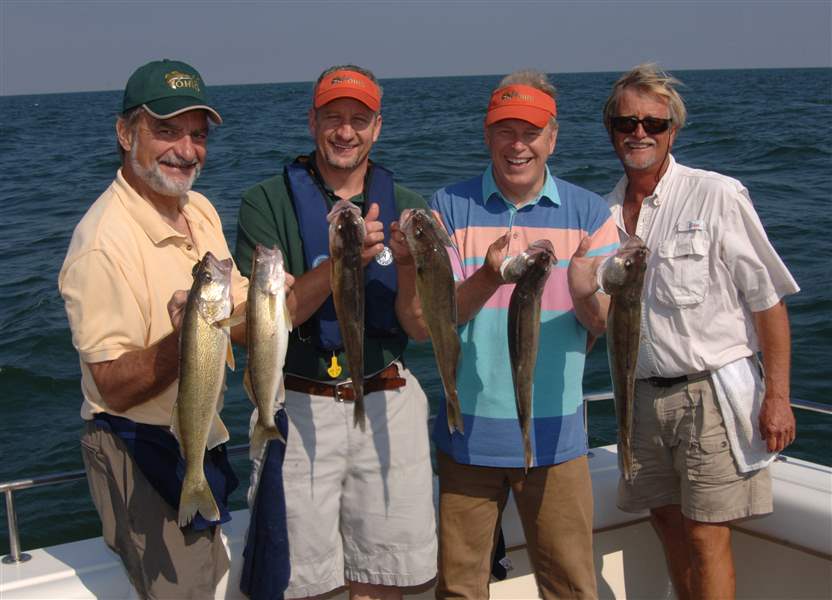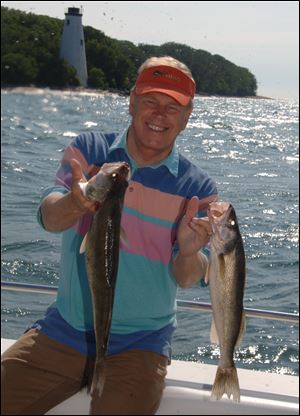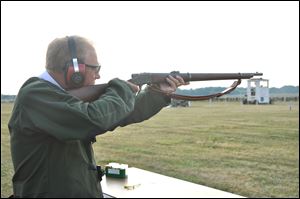
Strickland sounds alarm about carp invasion
7/13/2010
Blade outdoors editor Steve Pollock, from left, ODNR director Sean Logan, Gov. Ted Strickland and charter captain Paul Pacholski show off their day's catch.

Gov. Ted Strickland shows off two walleye he landed during Lake Erie Governor's Fish Ohio Day.
PORT CLINTON - The threat to the Great Lakes posed by the pending invasion of Asian carp at Lake Michigan could become a disaster that surpasses even that being caused to the Gulf Coast by the BP oil spill, Gov. Ted Strickland asserted Monday.
The governor, who was walleye fishing on western Lake Erie in the 31st annual Lake Erie Governor's Fish Ohio Day, took the opportunity to turn up the heat on the Asian carp threat.
At least two species of the carp, bighead and silver, have been moving up the Mississippi watershed since 1995 and displacing native fish and becoming a monstrous nuisance.
They are within six miles of Lake Michigan at Chicago, but the White House has taken a go-slow approach toward stopping them, and even the U.S. Supreme Court has twice refused to tackle it.

Blade outdoors editor Steve Pollock, from left, ODNR director Sean Logan, Gov. Ted Strickland and charter captain Paul Pacholski show off their day's catch.
Moreover, the invasive carp are exploding in Indiana's Wabash River, which is separated from Ohio's Maumee River watershed by only a few miles of floodplain at Fort Wayne. New fears loom that flooding, which has occurred in the past, could allow the carp to slip into the Maumee and make a beeline for Lake Erie, 130 miles distant.
"What bothers me is what seems to be a lack of urgency," charged the governor in an interview while fishing off the 82-acre West Sister Island, Ohio's only federally designated wilderness and home of the greatest colony of colonial wading birds on the Great Lakes.
In remarks later he urged, "time is of the essence. We can always do studies. We can take action now."
Last Thursday he urged the White House to hold an emergency summit about the carp threat next Monday. But he said he had heard nothing as of Monday.

Gov. Ted Strickland fires the ceremonial first shot of Matches at Camp Perry on Monday using a historic 1878 single shot Sharps .45/70 match rifle.
He noted that he was joined in a call to the White House by Michigan Gov. Jennifer Granholm, who echoed his sentiments in favoring a physical separation of Lake Michigan and the other connected Great Lakes from the Illinois River system, which is part of the Mississippi watershed. Artificial links were dug to connect the two systems decades ago, initially to carry away Chicago sewage.
"We are dealing with a catastrophic ecological and economic problem on the Gulf Coast that could have been prevented," Strickland said. "We have to decide there is another possible ecological disaster in terms of Asian carp getting into the Great Lakes.
"We can prevent it, but I have a continuing concern that we'll be talking about the catastrophe that hit the Great Lakes like the Gulf Coast." The governor noted that as bad as it is, Gulf ecology eventually, perhaps in decades, will recover from oil. But the Great Lakes fisheries, valued at $7 billion a year, could collapse with an explosive appearance of Asian carp.
Bigheads and silvers are voracious eaters that vacuum up the base of the food pyramid - the microscopic "stuff" on which everything else ultimately depends. Bigheads can reach 100 pounds, silver well over 20.
"It's a heck of a gamble," the governor charged. "It's just terrible," he said at
another point. "Lake Erie is a jewel. It is deserving of our pride and protection."
In contrast to possible perennial Great Lakes fisheries losses, Chicago and Illinois business and political interests complain of a total $4.7 billion economic loss from closing the rivers-lakes connection, which though substantial pales to one of $7 billion annually.
"If a physical barrier [between the rivers and lakes] would result in hardship in certain sectors of the economy, we acknowledge that. But it's easier to deal with that," he added.
So doing moreover, would involve lesser costs than postponing anti-carp action.
As for Fish Ohio Day, 15 charter captains from the Lake Erie Charter Boat Association volunteered their boats. Area businesses and lodgings supplied additional contributions.
All of the boats brought in fish, making it one of the more successful Fish Ohio days. The 495 pounds of fish caught at the event were donated to the Victory Temple Food Bank in Sandusky, where it serves families from the Port Clinton and Sandusky areas.
The day was sponsored by the Ohio Department of Natural Resources, its Division of Wildlife, LECBA, and Lake Erie Shores & Islands - West Welcome Center.
Strickland and his wife, Frances, an avid angler, were joined by members of the media, representatives of the tourism industry, elected officials, and conservation leaders to draw attention to Lake Erie.
For the first time, both the governor and first lady were in attendance, which added some good-natured rivalry to the mix. No one went without bragging rights - the governor caught one of the first walleye of the day, and the first lady's boat caught more fish than a number of other boats, including the governor's boat. A total of 165 fish were caught.
Mrs. Strickland, an avid angler, fished on an all-female crew with Capt. Peggy Van Vleet. They out-caught the governor's boat, 21 walleye to 10, the state's head man admitting his spouse is the better angler.
But the governor caught the first walleye on the day on the first cast of the day aboard Capt. Paul
Pacholski's Erie Hopper. It seemed too good to be true, a public relations put-up, but there it was.
Last evening, the governor was the honored guest at Camp Perry, west of here along the lake, opening the annual National Rifle and Pistol Matches in festive, traditional First Shot ceremonies in which he squeezed off the opening round to the six-week Matches. They begin today.
So it added up to a hook-and-bullet day for Strickland, a staunch supporter of firearms ownership rights who is A-rated by the National Rifle Association, one of the sponsors of the Matches with the Ohio National Guard and Civilian Marksmanship Program.
"Camp Perry is a marvelous asset," the governor said. "It is worthy of support."
During the fishing, the governor noted that in Lake Erie, "we have a magnificent resource, perhaps unique in the world. It's something in need of protection."
That is so, he added, not only because the lake and its tourism and fisheries boost the state economy and promote tourism, but also because "it's the right thing to do.
"Coming out to fish is fun and enjoyable, but [ODNR] Director [Sean] Logan and I have a responsibility beyond enjoying the lake.
"I feel bad because so many Ohioans have no real awareness of what the lake is and what it means," the governor continued. He said he is struck, for instance, with the money spent by families on Florida vacations "when everything Florida has to offer and even more is available in a two to three-hour drive at most."
Ohio's 1.1 million anglers spend an estimated $1.1 billion on fishing-related expenditures annually. Anglers contribute to local economies through the purchase of goods and services, as well as special taxes, licenses and other fees. Anglers support local jobs and wages, along with hotels, cottages and other lodging, marinas, charter boat services, restaurants, grocery stores, bait and tackle stores, marine suppliers and other local businesses. Their expenditures spur a $480 million sport fishing industry along Lake Erie and create nearly 10,000 jobs, according to the American Sportfishing Association.
The Lake Erie tourism economy means 114,000 jobs and $10.4 billion to Ohio, noted Larry Fletcher, executive director of Lake Erie Shores and Islands Welcome Center - West.
"Statistics measure the benefits of the lake, but numbers don't tell the whole story," Logan said. "Just as important as numbers, the memories we have of time spent on the lake, afternoons fishing or boating, and just the sights and sounds of Lake Erie build quality of life and a sense of community. Fish Ohio Day is one way to remind people of all that is at stake in the Lake Erie watershed."
He noted that Erie produces more fish than the rest of the Great Lakes combined.
"What we do to our land impacts our water directly," he added, referring to extensive problems at the 13,000-acre Grand Lake St. Marys in Mercer and Auglaize counties, where decades of pollution and continuing farm-chemical runoff have caused an ecological collapse and blooms of poisonous blue-green algae.
Logan, with Ohio EPA director Chris Korleski nodding in agreement in the audience, noted that such nonpoint threats and algae blooms are slowly threatening the 2.25-million-acre Lake Erie as well. This represents a long-term challenge beyond Asian carp.
Contact Steve Pollick at:
spollick@theblade.com
or 419-724-6068.